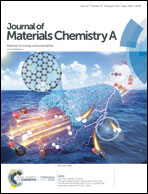An MnO2–Ti3C2Tx MXene nanohybrid: an efficient and durable electrocatalyst toward artificial N2 fixation to NH3 under ambient conditions†
Abstract
Industrial synthesis of NH3 relies mainly on the traditional Haber–Bosch process, which is highly energy-intensive with enormous greenhouse gas emission. Electrochemical N2 reduction provides an eco-friendly approach for energy-saving NH3 synthesis, but it requires highly efficient electrocatalysts under ambient conditions. In this communication, an MnO2-decorated Ti3C2Tx (T = F, OH) MXene nanohybrid (MnO2–Ti3C2Tx) is proposed as a highly active electrocatalyst for the N2 reduction reaction with strong durability. In addition, only the NH3 product without N2H4 can be detected during the NRR, revealing the excellent selectivity of MnO2–Ti3C2Tx for NH3 formation. A high NH3 yield of 34.12 μg h−1 mgcat−1 and a high faradaic efficiency of 11.39% are achieved at −0.55 V vs. a reversible hydrogen electrode in 0.1 M HCl. Density functional theory calculations further reveal that the unsaturated surface Mn atoms act as active sites to adsorb and activate the inert N2 molecules for the NRR process, and the rate-determining step is the first hydrogenation process.



 Please wait while we load your content...
Please wait while we load your content...